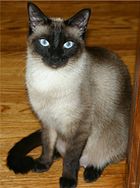Cat coat genetics can produce a variety of coat patterns. Some of the most common are:
- Bicolor, Tuxedo and Van
- This pattern varies between the tuxedo cat which is mostly black with a white chest, and possibly markings on the face and paws/legs, all the way to the Van pattern (so named after the Lake Van area in Turkey, which gave rise to the Turkish Van breed), where the only colored parts of the cat are the tail (usually including the base of the tail proper), and the top of the head (often including the ears). There are several other terms for amounts of white between these two extremes, such as Harlequin or jellicle cat. Bicolor cats can have as their primary (non-white) color black, red, any dilution thereof, and tortoiseshell (see below for definition).
- Tabby cat
- Striped, with a variety of patterns. The classic "blotched" tabby (or "marbled") pattern is the most common and consists of butterflies and bullseyes. The "mackerel" or "striped" tabby is a series of vertical stripes down the cat's side (resembling the fish). This pattern broken into spots is referred to as a "spotted" tabby. Finally, the tabby markings may look like a series of ticks on the fur, thus the "ticked" tabby, which is almost exclusively associated with the Abyssinian breed of cats. The worldwide evolution of the cat means that certain types of tabby are associated with certain countries; for instance, blotched tabbies are quite rare outside NW Europe, where they are the most common type.
- Tortoiseshell and Calico
- This cat is also known as a Calimanco cat or Clouded Tiger cat, and by the nickname "tortie." In the cat fancy, a tortoiseshell cat is randomly patched over with red (or its dilute form, cream) and black (or its dilute blue) mottled throughout the coat. Additionally, the cat may have white spots in its fur, which make it a "tortoiseshell and white" cat or, if there is a significant amount of white in the fur and the red and black colors form a patchwork rather than a mottled aspect, the cat will be called a "calico." All calicos are tortoiseshell (as they carry both black and red), but not all tortoiseshells are calicos (which requires a significant amount of white in the fur and patching rather than mottling of the colors). The calico is also sometimes called a "tricolor cat." The Japanese refer to this pattern as mi-ke (meaning "triple fur"), while the Dutch call these cats lapjeskat (meaning "patches cat"). A true tricolor must consist of three colors: a reddish color, dark or light; white; and one other color, typically a brown, black, or blue. Both tortoiseshell and calico cats are typically female because the coat pattern is the result of differential X chromosome inactivation in females (which, as with all normal female mammals, have two X chromosomes). Conversely, cats where the overall color is ginger (orange) are commonly male (roughly in a 3:1 ratio). In a litter sired by a ginger tom, the females will be tortoiseshell or ginger. Male tortoiseshells can occur as a result of chromosomal abnormalities (often linked to sterility) or by a phenomenon known as mosaicism, where two early stage embryos are merged into a single kitten.
- Colorpoint
- The colorpoint pattern is most commonly associated with Siamese cats, but may also appear in any domesticated cat. A colorpointed cat has dark colors on the face, ears, feet, and tail, with a lighter version of the same color on the rest of the body, and possibly some white. The exact name of the colorpoint pattern depends on the actual color, so there are seal points (dark brown), chocolate points (warm lighter brown), blue points (dark gray), lilac or frost points (silvery gray-pink), red or flame points (orange), and tortie (tortoiseshell mottling) points, among others. This pattern is the result of a temperature sensitive mutation in one of the enzymes in the metabolic pathway from tyrosine to pigment, such as melanin; thus, little or no pigment is produced except in the extremities or "points," where the skin is slightly cooler. For this reason, colorpointed cats tend to darken with age as bodily temperature drops; also, the fur over a significant injury may sometimes darken or lighten as a result of temperature change.
- The tyrosine pathway also produces neurotransmitters, thus mutations in the early parts of that pathway may affect not only pigment, but also neurological development. This results in a higher frequency of cross-eyes among colorpointed cats, as well as the high frequency of cross-eyes in white tigers.
- White cats
- True albinism (a mutation of the tyrosinase gene) is quite rare in cats. Much more common is the appearance of white coat color due to a lack of melanocytes in the skin. A higher frequency of deafness in white cats is due to a reduction in the population and survival of melanoblast stem cells, which in addition to creating pigment producing cells, develop into a variety of neurological cell types. White cats with one or two blue eyes have a particularly high likelihood of being deaf.
- Smoke cats
- The bottom eighth of each hair is white or creamy-white, with the rest of the hair being a solid color. Genetically this color is a non-agouti cat with the dominant inhibitor gene; a non-agouti version of the silver tabby. Smoke cats will look solid colored until they move, when the white undercoat becomes apparent. It is mostly found in pedigreed cats (especially longhair breeds) but also present in some domestic longhaired cats.









No comments:
Post a Comment